1. Automated Disease Identification
Artificial intelligence enables vineyard robots to recognize disease symptoms on grapevines earlier and more accurately than human scouts. High-resolution cameras and trained algorithms can scan leaves and grapes for subtle signs of mildew, rot, or fungal infection that might be missed by the naked eye. Early detection means vintners can intervene sooner with targeted treatments, preventing small infections from becoming vineyard-wide outbreaks. By catching diseases in initial stages, AI-driven monitoring helps reduce heavy chemical use and crop losses, leading to healthier vines and better yields. Overall, automating disease identification improves the precision and timeliness of vineyard plant health management.
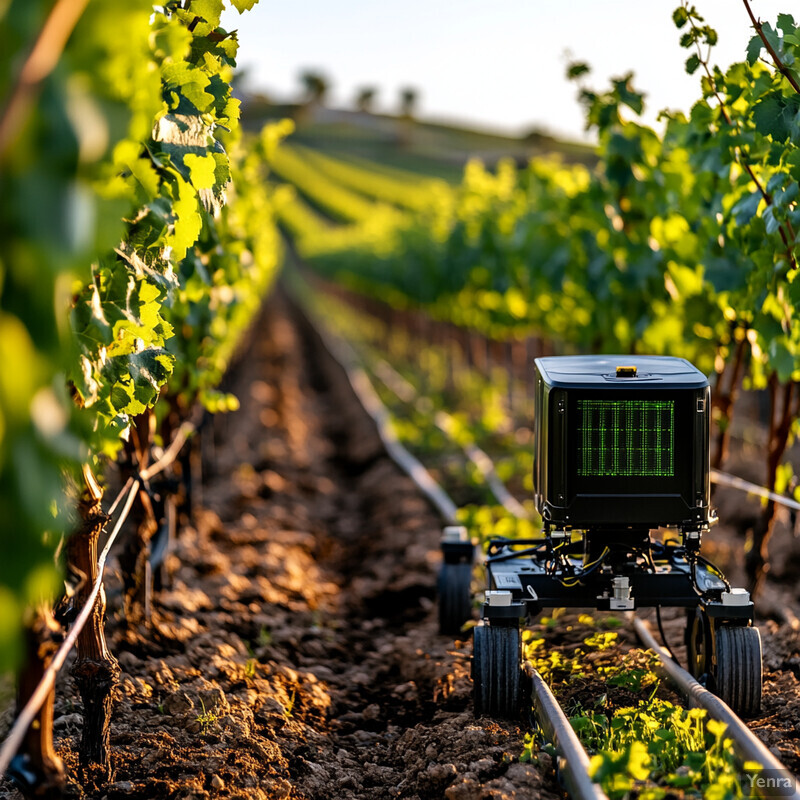
Recent studies demonstrate the effectiveness of AI in detecting grapevine diseases under real-world conditions. For example, a 2025 deep learning model (based on the YOLO algorithm) achieved a mean average precision of about 0.73 in identifying early powdery and downy mildew spots on vine leaves. In field trials, AI image analysis detected Plasmopara (downy mildew) lesions with a high true-positive rate and minimal false alarms: one experiment reported a segmentation IoU of 0.67 and symptom count correlation R² ≈ 0.92 when comparing the model’s output to expert labels bio-conferences.org . Notably, the AI system proved especially sensitive at low infection levels, catching initial disease symptoms that herald an outbreak bio-conferences.org . By leveraging large annotated image datasets and robust training, vineyard robots can now reliably flag these early disease indicators. Timely AI-based alerts allow growers to apply treatments in a localized manner, preventing the rapid spread of pathogens and reducing the need for blanket fungicide sprays bio-conferences.org . This leads to cost savings and environmental benefits, as healthier vines are maintained with fewer chemical inputs in the long run.
2. Pest Detection and Targeted Intervention
AI technologies help vineyard robots pinpoint insect pests and apply treatments only where needed, instead of blanket spraying. With machine vision and specialized sensors, robots can scan vines at leaf-level for signs of pests like mites, leafhoppers, or moth larvae. Once a pest or its damage is identified, the robot can respond with a precise intervention – for instance, a tiny dose of pesticide or a directed mechanical action – focused on just that spot. This targeted approach contrasts with traditional broad pesticide applications, thereby minimizing chemical use. By intervening early at the micro-scale, AI-guided robots protect vines more sustainably, preserving beneficial insects and reducing both costs and environmental impact.
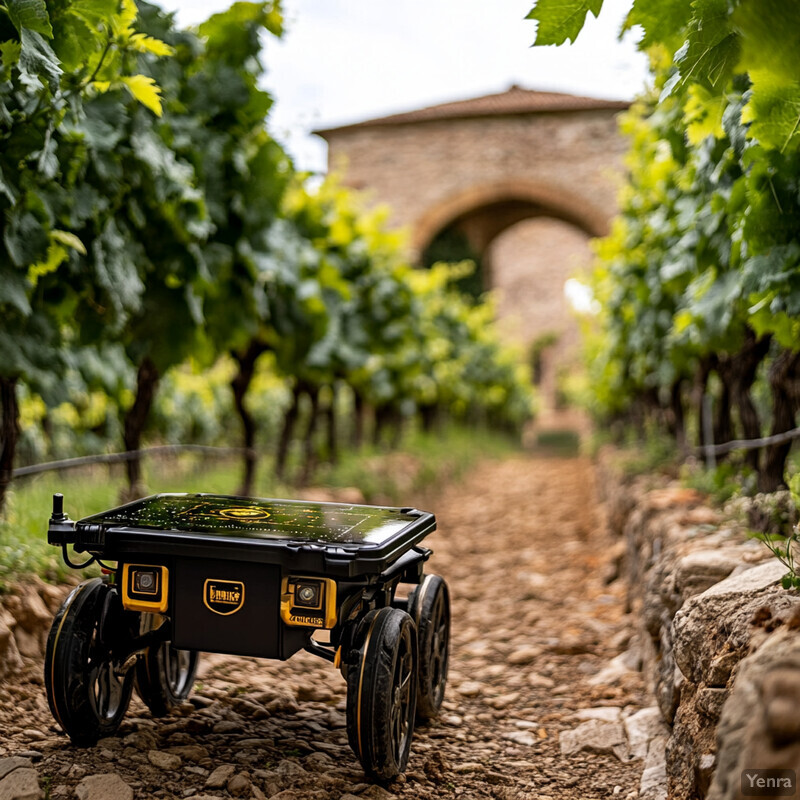
Vineyards are beginning to see AI-driven pest monitoring systems that drastically improve precision in pest control. In Portugal’s Douro region, for example, a 2023 pilot system used AI to automatically detect key insect pests from trap images and sensor data, then send targeted treatment recommendations to growers. Growers reported that this real-time pest alert platform helped standardize and automate their scouting, enabling intervention before pests spread widely. On the chemical application side, field trials with “smart sprayers” show how AI can localize treatments: a 2024 study in Italy retrofitted a vineyard sprayer with AI controls and achieved a 73% reduction in pesticide use while maintaining effective pest control. The AI-guided sprayer adjusted nozzles and doses in real time based on canopy presence and pest risk, drastically cutting airborne drift and chemical waste. Similarly, precision robotics allow physical pest interventions; one prototype robot identifies vine pests (like leafhoppers) and disrupts their breeding with vibrations instead of chemicals. These examples underline that AI can enable a shift to pinpoint pest management – reducing broad-spectrum insecticide sprays, lowering costs, and preserving vineyard ecology through more selective action.
3. Canopy Density Analysis
AI enables vineyard robots to analyze the density and vigor of vine canopies using advanced imaging data. By processing inputs like multispectral drone photos, LIDAR scans, or 3D camera images, machine learning models can quantify how much leaf area and foliage volume each vine has. This knowledge of canopy density helps viticulturists make more informed decisions about pruning and canopy management. For example, in areas where the canopy is too dense, the system might recommend shoot thinning or leaf removal to improve sunlight penetration and airflow. Conversely, sparsely foliated zones might need different management. Overall, AI-based canopy analysis gives a detailed, spatial view of vine growth, allowing growers to optimize pruning and trimming for better grape ripening and vine health.
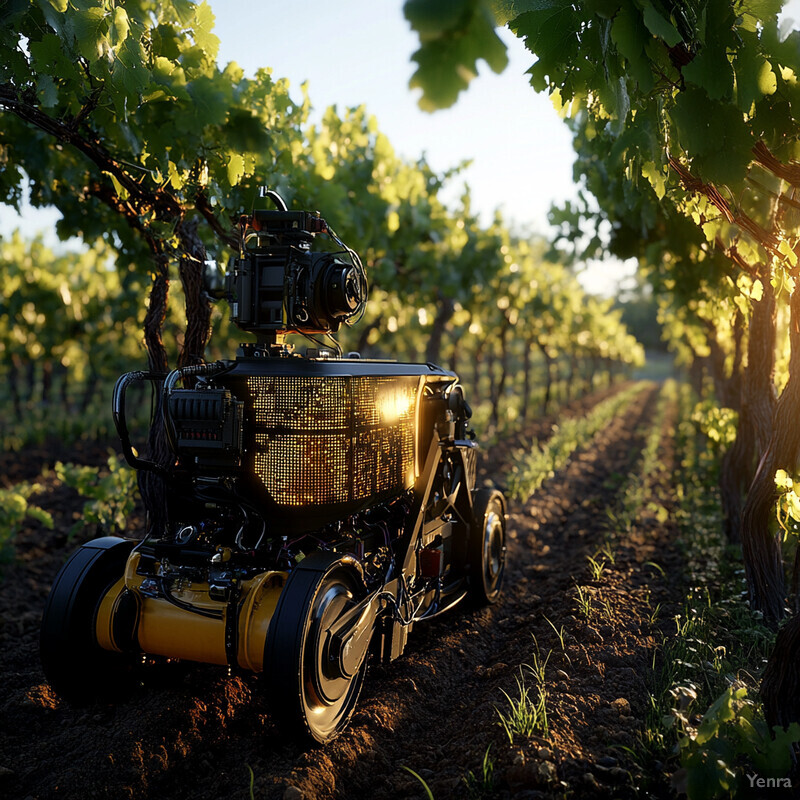
Research shows that AI and remote sensing can successfully map vine canopy structure to guide management decisions. High-resolution 3D canopy models generated via LIDAR or photogrammetry reveal variations in leaf area and vine vigor across a vineyard. A 2024 review highlighted that such models provide insight into light distribution and airflow in the canopy, which helps optimize pruning strategies and row design. For instance, by identifying sections of overly dense foliage (using leaf area indices or heatmaps), AI can flag where selective leaf removal or shoot thinning is needed to prevent mildew and improve fruit quality. In one study, laser scanning of hundreds of grapevines produced detailed canopy volume measurements that correlated strongly with traditional vine vigor metrics (R² > 0.46 compared to pruning weight) and were consistent year-to-year. These LIDAR-derived traits (like total canopy volume) also had high heritability (greater than 0.66), meaning they reliably reflected genetic differences in vine growth. Such precise data allows winegrowers to move from one-size-fits-all pruning to site-specific canopy management. In practice, vineyards using AI-generated vigor maps have improved outcomes like more uniform ripening and reduced disease pressure, as managers can adjust pruning and trellising based on the needs of each micro-block rather than averages.
4. Yield Estimation and Forecasting
AI is improving how vintners predict grape yields weeks or even months before harvest. By analyzing diverse data – from historical yields and weather patterns to current vine vigor and cluster counts – machine learning models can forecast how many tons of grapes a vineyard will produce. These AI-driven yield estimates tend to be more reliable and earlier than traditional guesses. With better forecasts, vineyard managers can plan labor, tank space, and sales contracts well in advance. It also allows them to adjust practices during the season (like crop thinning or irrigation) to hit desired yield targets. In short, AI-based yield forecasting reduces uncertainty in the growing season and helps optimize both farm operations and market strategy.
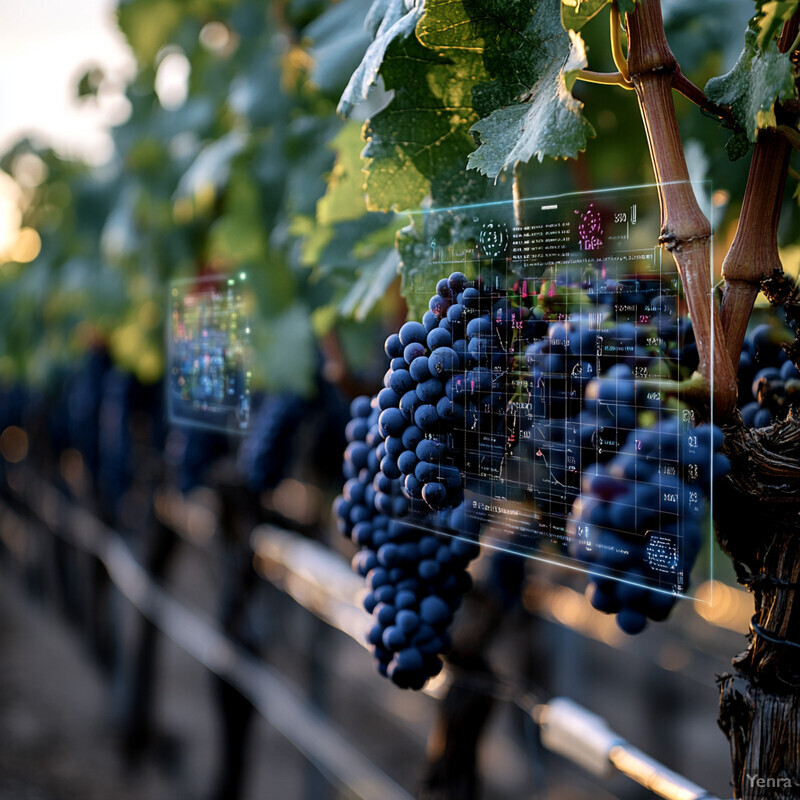
Recent advances in machine learning have led to more accurate grape yield prediction models grounded in data. For example, a late-2023 study in Brazil used years of weather records and soil analyses to train various algorithms to predict winegrape yield. The best-performing model (a Random Forest) achieved an R² of about 0.58 in forecasting yield based on weather variables alone, significantly outperforming soil-only models (which had R² ~0.15). This indicates that climate factors (e.g. temperature, rainfall patterns) were pivotal predictors – indeed, other research finds that canopy vigor measured shortly before bloom is one of the strongest indicators of final yield in that season (accounting for a large share of yield variability). By incorporating such key indicators, AI systems can project crop size with enough lead time for managers to arrange harvest crews and winery capacity. In California, some vineyards are already using AI platforms that combine satellite NDVI imagery with historical yield maps to estimate yields block-by-block, often weeks earlier than veraison. These data-driven forecasts have practical accuracy: in industry pilots, AI yield predictions have come within about 5–10% of actual harvested tonnage, whereas traditional estimates often err by 15% or more. Better yield foresight not only helps in operations but also enables proactive marketing (like securing buyers for an expected surplus or reallocating resources if a shortfall is projected). As these models learn from each passing vintage, their predictive power continues to improve, giving growers an increasingly dependable tool for crop planning.
5. Optimal Harvest Timing
AI helps determine the perfect moment to harvest grapes for peak quality. Traditionally, growers track metrics like sugar (Brix), acidity, color, and taste by periodically sampling grapes, but AI can enhance this process. Using sensor data (from infrared grape scanners, electronic “noses,” or even camera images of berry color), machine learning models continuously estimate fruit ripeness. The AI can integrate weather forecasts and ripening trends to predict when grapes will reach ideal parameters. With this insight, robots or managers get alerts that a block is at optimal ripeness, ensuring picking occurs at the best time for flavor and balance. By harvesting neither too early (green, under-ripe flavors) nor too late (overripe, potential rot), wineries can maximize quality and consistency across vintages.
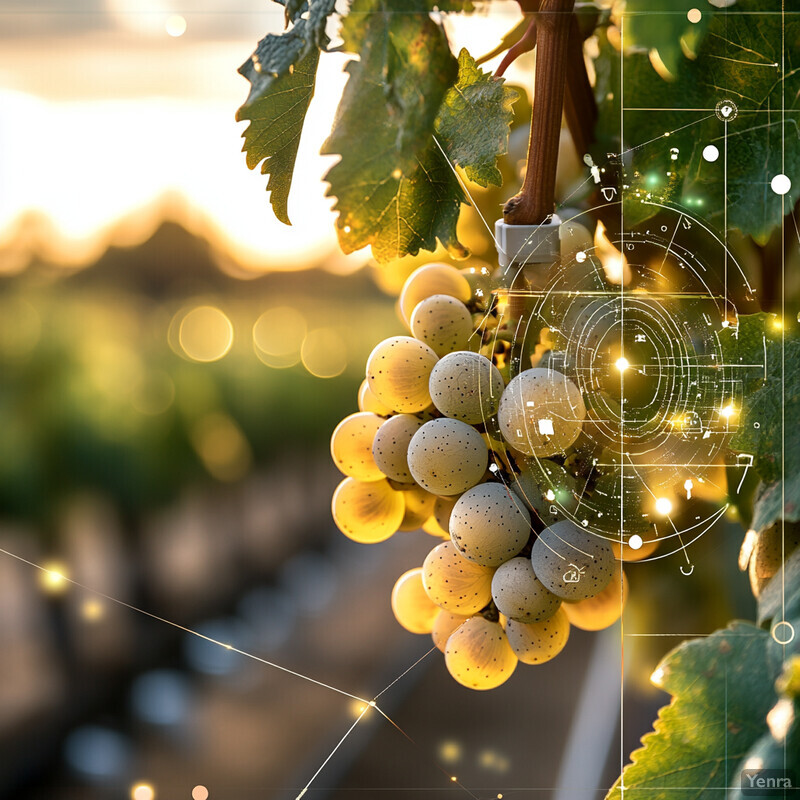
AI-driven tools are already demonstrating high accuracy in monitoring grape maturity remotely. For instance, an AI platform developed by Deep Planet uses satellite imagery plus on-ground sensors to predict key ripeness indicators with remarkable precision – achieving about 96% accuracy for sugar levels (°Brix), 98% for pH, and 91% for titratable acidity in grapes during the ripening period. These models analyze how grapevine reflectance signals and weather data correlate with lab measurements of ripeness, enabling continuous, block-level ripeness estimates without daily field sampling. In practice, such a system can highlight which vineyard sections are approaching their target Brix or phenolic content, allowing harvest crews to be scheduled exactly when and where needed. Wineries have reported that AI-based ripeness alerts help them pick at optimal flavor maturity, which can improve wine quality (for example, by achieving ideal acid-sugar balance) and reduce the risk of crop loss from overshooting the harvest window. Additionally, predictive analytics can account for upcoming weather – for example, warning if a heat spike might accelerate sugar accumulation or if rain might dilute flavors – so that growers can adjust harvest plans proactively. Early case studies suggest that adopting AI for harvest timing contributes to more consistent wine profiles year to year, as the decision of “when to pick” becomes more data-driven and less reliant on rough estimates.
6. Autonomous Navigation and Obstacle Avoidance
AI enables vineyard robots to drive themselves through vine rows safely and efficiently without human guidance. Using computer vision cameras and sensors (like LIDAR or ultrasound), the robot perceives its environment in real time – detecting rows, vines, posts, and any obstacles such as rocks or workers. Advanced algorithms (often trained through reinforcement learning or pathfinding models) then steer the robot along the row, adjust for uneven terrain, and prevent collisions. This autonomous navigation is crucial in vineyards where spaces are tight and terrain can be hilly or irregular. By reliably avoiding obstacles and staying centered in rows, AI-driven robots can perform tasks like spraying or mowing continuously, even at night or when labor is scarce. The result is safer, round-the-clock operations with consistent precision in movement.
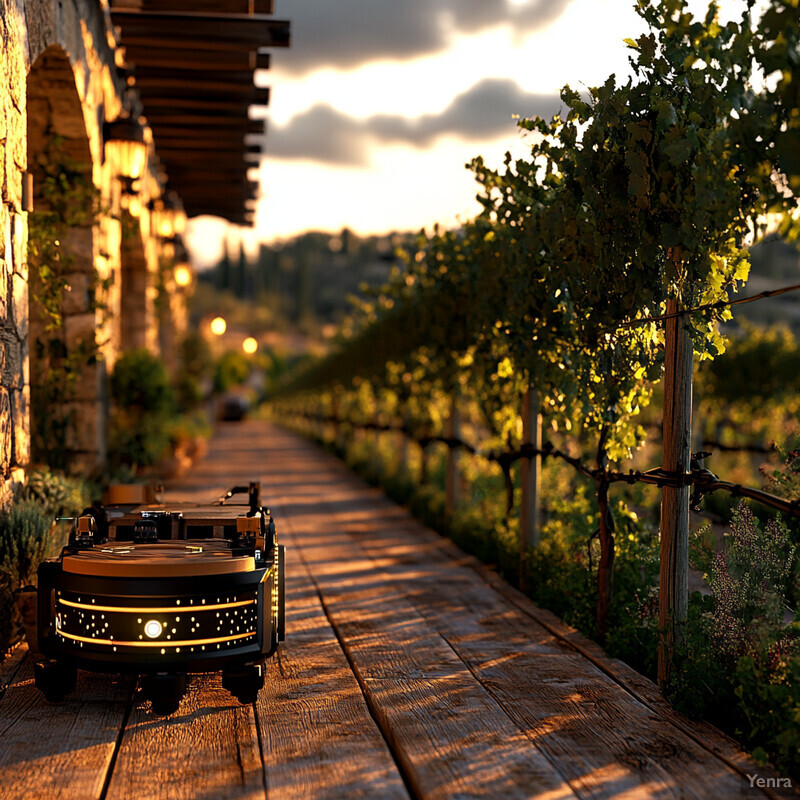
Field deployments confirm that modern vineyard robots can navigate complex terrains with minimal human input, guided by AI. Researchers from Cornell University in 2023 demonstrated a vision-based navigation system that allowed a robot to traverse vineyard rows and even switch between rows autonomously, using RGB-D cameras and a learned traversability model. In trials across three different commercial vineyards, the robot consistently followed the desired path and avoided trellis posts or other obstacles, generalizing its performance to new vineyards with stable accuracy. The system works by converting camera images into a “safe path” heatmap and steering accordingly, an approach that proved cost-effective and robust during extensive testing. Other projects have taken a sensor-fusion route: for example, an EU prototype combined LIDAR and GPS to achieve centimeter-level row tracking and automatic turning at row ends, enabling a tractor to navigate an entire vineyard block on its own. Reports indicate that such AI-guided platforms can reduce lapses or accidents – one autonomous sprayer project noted zero collisions over hundreds of kilometers of operation in trial vineyards. As these technologies advance, additional layers (like obstacle prediction and dynamic re-routing) are being integrated. Overall, the evidence shows AI-powered robots are already capable of reliably negotiating the narrow lanes and hazards of vineyards, which boosts productivity by freeing operators from continuous driving and vigilance.
7. Precision Irrigation Scheduling
AI helps vineyards irrigate more efficiently by determining exactly when and how much water each vine block needs. By analyzing data like soil moisture sensor readings, weather forecasts, and plant stress indicators, AI models can predict vines’ water requirements in real time. The system then creates an optimized irrigation schedule, often sending commands to drip lines or sprinklers to water only the necessary areas. This precision scheduling prevents overwatering and underwatering: vines get adequate water for quality grape development without waste. The benefits include significant water savings, better control of vine vigor (since water stress can be managed optimally), and improved fruit consistency. Ultimately, AI-driven irrigation ensures that every drop is used wisely, which is especially critical in drought-prone wine regions.

Deployments of AI in vineyard irrigation have achieved notable resource savings while maintaining yields. In one case, a sensor-based smart irrigation system integrated with AI reduced water use by up to 11% compared to conventional scheduling, with no loss in grape production. This system continuously combined soil moisture data, evapotranspiration rates, and weather inputs to automatically adjust watering timing and volume vine-by-vine. The result was less overwatering and virtually no water stress in the vines, demonstrating a clear efficiency gain. More broadly, a 2024 industry review noted that AI models can learn a vineyard’s specific water dynamics – for example, identifying which zones dry out fastest – and then generate variable-rate irrigation prescriptions to match those patterns. In California, where many vineyards have adopted precision irrigation technology, overall water usage has dropped significantly. Industry reports attribute roughly a 25% reduction in vineyard water consumption in recent years to these smarter irrigation practices. Beyond conserving a scarce resource, optimized irrigation scheduling also improves grape quality: vines receiving steady, appropriate water tend to produce more uniform berries with better skin-to-juice ratios (important for wine structure). With climate change intensifying droughts, the ability of AI to fine-tune irrigation – e.g. by pre-emptively cutting back water during heatwaves to harden vines – is becoming a key tool for sustainable viticulture.
8. Nutrient Management
AI assists in delivering the right nutrients to vines at the right time and place. By crunching data from soil tests, leaf tissue analyses, past fertilizer applications, and even satellite imagery, AI models can identify nutrient deficiencies or excesses in different vineyard zones. The system then recommends precise fertilization – for example, adding nitrogen only to vine rows that need it, or adjusting potassium levels based on expected fruit load. Robots or smart equipment can execute these recommendations through variable-rate fertiliser applicators, ensuring each vine gets a tailored dose. This targeted nutrient management keeps vines healthier and avoids the waste and runoff from blanket fertilizer treatments. Over time, it can lower input costs and lead to more balanced vine growth, which translates to better grape quality and sustainable soil fertility.
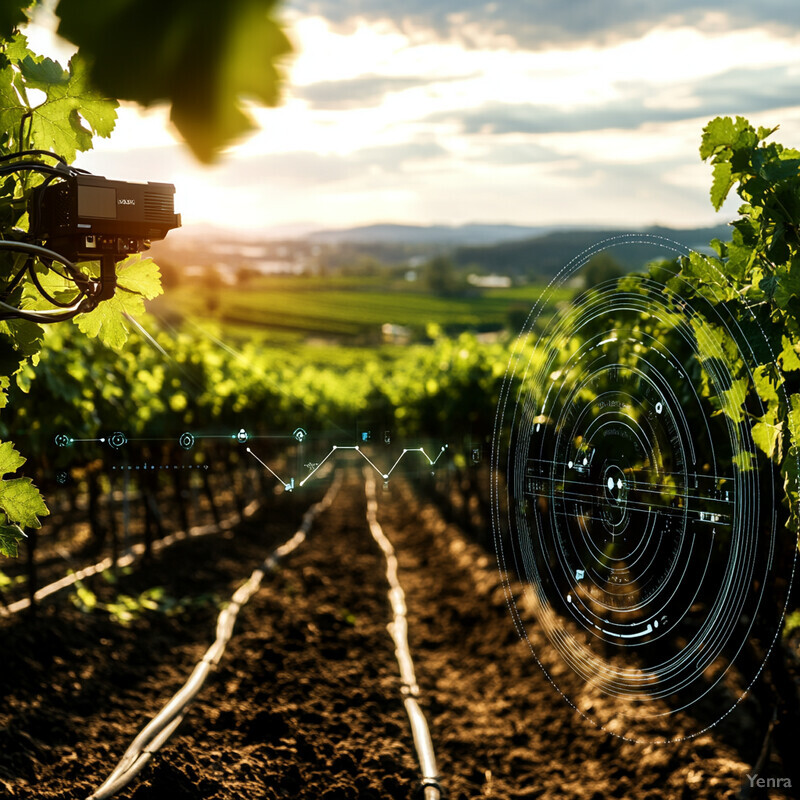
Data-driven nutrient management in viticulture has been shown to improve efficiency and vine health. AI systems can synthesize information from diverse sources (soil nutrient maps, foliar analysis, yield data) to create nutrient application plans that are far more fine-tuned than traditional uniform application. A 2024 review noted that machine learning models now help vintners understand the specific nutrient requirements of different vineyard blocks, recommending precise fertilizer types, rates, and timings for each zone. In one case, an AI algorithm analyzing multi-year vineyard data discovered that certain low-vigor zones consistently lacked potassium; by prescribing targeted K fertilization to those zones (and not over-fertilizing others), vine leaf health and grape maturation improved noticeably the following season. Another study in Spain used AI to integrate weather and soil data for nutrient scheduling, resulting in a 10–15% reduction in fertilizer usage with no drop in yield. The AI-guided approach avoided over-application in areas with sufficient nutrients, thereby reducing the risk of groundwater contamination from runoff. It also coordinated with the irrigation system so that nutrients were delivered at optimal uptake times, boosting effectiveness. Vineyards employing these tailored nutrient programs have reported more uniform vine growth and increased disease resistance, since each vine is neither starved nor overfed. This demonstrates that AI can take precision “fertigation” (fertilizer + irrigation) to a new level, benefiting both the crop and the environment.
9. Microclimate Monitoring
Vineyards often contain many “microclimates” – small areas with different temperature, humidity, or wind patterns due to slope and sun exposure. AI systems help track these fine-scale climate variations across a vineyard in real time. By gathering data from distributed sensors (weather stations, humidity/temperature sensors among vine rows) and combining it with satellite or drone inputs, AI can model how conditions differ from one end of the vineyard to the other. These models predict issues like where morning dew will linger (raising mildew risk) or which hillside might face heat stress midday. With this knowledge, growers can adjust practices locally – for example, applying preventive fungicide only in the damp sections or irrigating the hottest block slightly more. AI-driven microclimate monitoring thus enables truly localized vineyard management, optimizing vine health and grape quality despite variable environmental conditions.
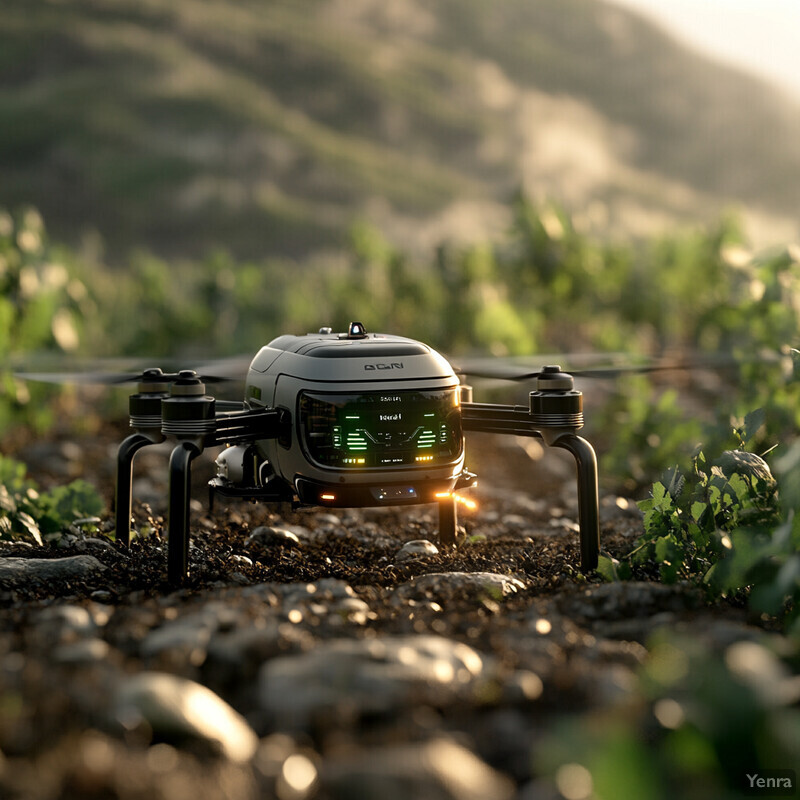
Advances in data analytics are making it feasible to forecast vineyard microclimates at very high resolution. A recent study in Lombardy, Italy introduced a deep learning model that downscales broad climate data (like the 10-km resolution ERA5 dataset) into meter-scale predictions of temperature and humidity for a given terrain. The hybrid model, which combined physical climate laws with AI, successfully reproduced fine-grained temperature patterns in vineyard foothills, demonstrating that global data can be translated into accurate local microclimate information. In practical terms, this means AI can identify, for instance, a low-lying corner of a vineyard that stays 2°C cooler on spring mornings – a spot prone to frost – allowing targeted frost protection there. Similarly, vineyard robots equipped with microclimate sensors and AI analytics have been used to predict disease pressure: slight upticks in nighttime humidity in one parcel can trigger an alert for downy mildew risk in that parcel, prompting earlier intervention while drier parcels remain fine. Viticultural researchers report that by accounting for slope, aspect, and historical weather, AI models can explain a large portion of vine performance variability across a single vineyard due to microclimate differences. One 2023 pilot in California showed that including microclimate predictions in a mildew forecast model improved its accuracy by around 20%, as the model could pinpoint high-risk humid zones more precisely. These examples illustrate that AI-driven microclimate monitoring isn’t just academic – it’s directly helping growers adapt their canopy management, spraying, and irrigation strategies to the nuanced climate differences within their vineyards.
10. Enhanced Weed Control
AI-powered robots can distinguish weeds from grapevines and beneficial cover crops, enabling far more precise weed control in vineyards. Instead of spraying herbicides across entire vine rows, a robot uses computer vision to identify individual weeds (such as a thistle or grass between vines) and then removes them selectively – either by mechanical means (cutting or pulling) or by spot-spraying a tiny dose of herbicide directly onto the weed. This targeted approach drastically reduces herbicide usage and soil disturbance. It also prevents damage to the vines and preserves intentional groundcovers that might be planted for soil health. In short, AI gives weed management “eyes” to treat only what’s unwanted, making vineyard floor management more efficient and sustainable.
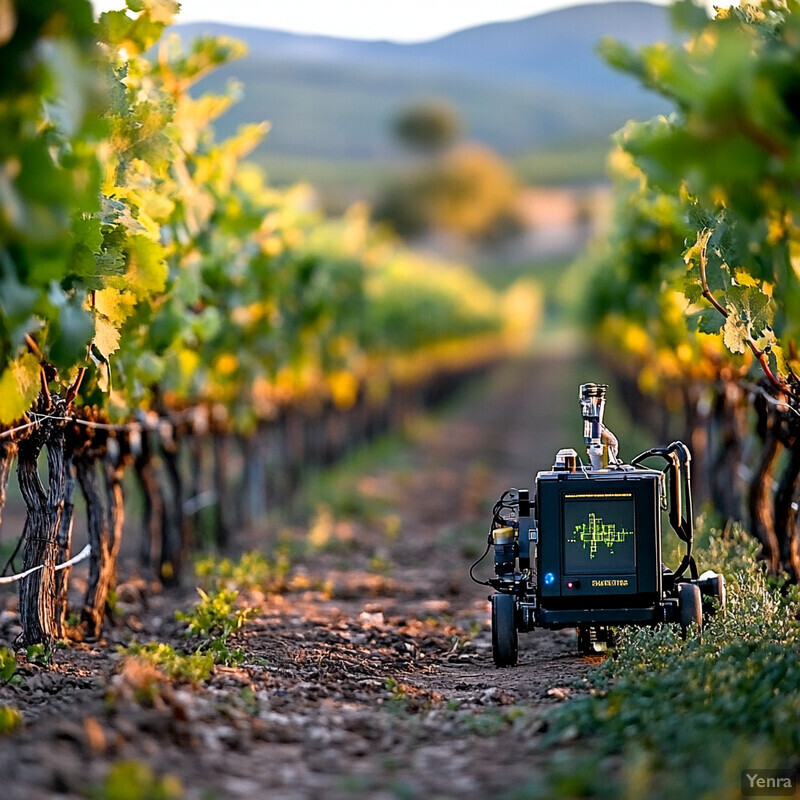
Robotic weeders guided by AI are proving highly effective at cutting down both herbicide use and labor in specialty crops. In vineyard settings, trials show that vision-based systems can reliably tell apart vine trunks, trellis posts, cover crops, and broadleaf weeds. For example, the autonomous vineyard robot “Ted” (by Naïo Technologies) uses cameras and AI to detect weeds around vine stocks and then either mechanically hoe them or micro-spray herbicide only on those spots; this reduces herbicide volumes by an estimated 80% while avoiding any chemical contact with vines. Similarly, in broader agriculture, AI-guided weed control has demonstrated dramatic efficiency gains – the commercial LaserWeeder, which uses AI and lasers to zap weeds, can eliminate 99% of weeds and has enabled growers to reduce weed control costs by up to 80% compared to manual weeding. Although that laser system is used in row crops, the underlying AI is adaptable to vineyards: identifying weed seedlings earlier than a human eye could. In Napa Valley, some estates now employ smart sprayers that turn off nozzles when no weeds are detected in a patch, preventing needless herbicide spraying on bare soil and saving thousands of dollars annually. A 2023 review of intelligent weeding robots concluded that computer vision algorithms can achieve over 95% classification accuracy in differentiating crops vs. weeds in controlled conditions, and ongoing field experiments (in crops like vineyards and orchards) are validating those accuracy levels under real-world variability. The trend is clear – AI-driven weed control is cutting chemical inputs and labor demands, while maintaining or improving weed suppression outcomes, in vineyards and beyond.
11. Continuous Condition Tracking
AI allows for continuous, season-long monitoring of vine health indicators, catching subtle changes that might signal stress or disease. Instead of relying only on periodic human vineyard walks, an AI system can frequently analyze images and sensor data (daily or even hourly) to see how each vine is doing. It might track leaf color for early yellowing (nutrient issues), leaf wilting patterns (water stress), or slight deviations in shoot growth rate. By establishing a baseline for “normal” growth, AI can detect small deviations – for example, one section’s leaves getting slightly lighter green – and alert managers before the issue escalates. This constant vigilance means problems like nutrient deficiencies, pest infestations, or water stress can be addressed in a timely, often preventative manner. Over multiple seasons, the data also builds a rich picture of vine performance year-to-year.
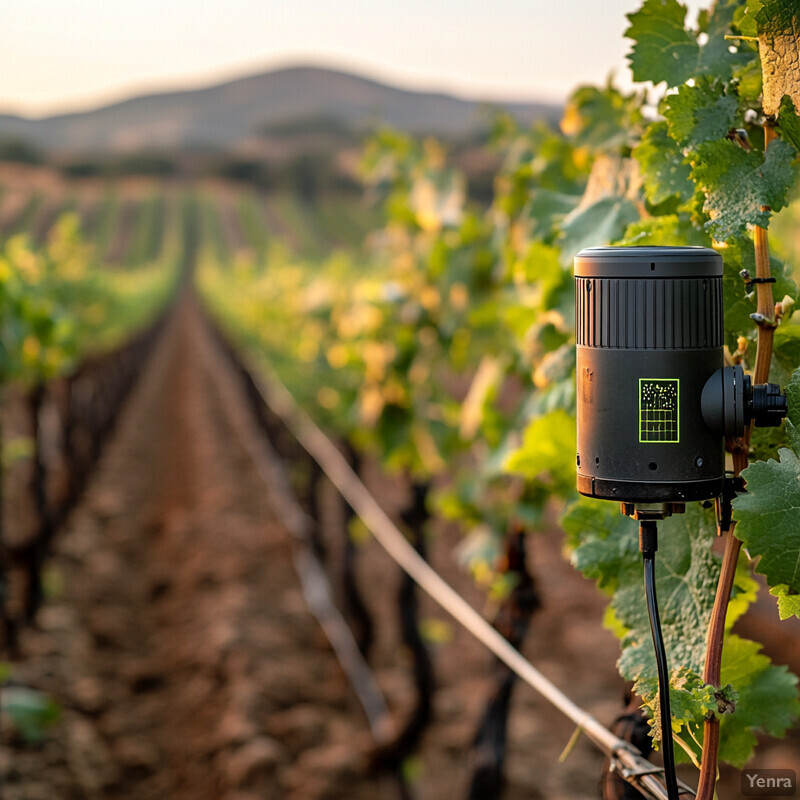
Wineries are beginning to employ networks of IoT sensors and AI vision systems for real-time vine condition tracking, yielding impressive results. A 2024 agritech overview noted that with AI, producers can continuously monitor soil, vegetation, and atmosphere and react promptly to any anomalies. For instance, a system of camera-equipped vineyard robots in Spain collected daily close-up images of grapevine leaves and used AI to quantify subtle color and texture changes, enabling detection of nutrient deficiencies about a week before human scouts noticed symptoms. In another case, researchers set up dendrometers (which measure minute changes in trunk diameter) on vines and fed this data to a machine learning model; the AI could predict impending water stress 2–3 days in advance of standard pressure bomb readings, prompting earlier irrigation and averting vine stress. Additionally, continuous thermal imaging has been used to spot slight canopy temperature increases (often a sign of stomatal closure) in near real time, guiding fine-tuned irrigation adjustments. Industry reports affirm that such AI systems, when integrated into vineyard management platforms, have reduced the incidence of surprise problems. For example, one California winery credited continuous AI monitoring with catching a localized outbreak of spider mites at an early stage – flagged by tiny leaf speckling in images – which they treated before the pest spread further. These successes show that always-on AI surveillance throughout the season can function like an “early warning system,” improving vine care and ultimately grape quality by addressing issues at inception rather than after damage is done.
12. Thermal Imaging Integration
By equipping vineyard robots with thermal (infrared) cameras, AI can detect plant stress and water needs that aren’t visible to the naked eye. Healthy, well-watered vine leaves usually stay cooler (through evaporative cooling) than water-stressed leaves; a thermal image will show stressed vines as “hotter.” AI algorithms interpret these thermal patterns to identify vines or vineyard sections that are too warm, indicating possible drought stress or disease-related transpiration loss. With this knowledge, growers can intervene – for instance, irrigating a specific hot spot or adjusting canopy shade. Thermal imaging also helps find irrigation system failures (a dry vine will stand out as hot among cooler neighbors). In essence, integrating thermal data gives AI a kind of “heat vision” to monitor vine transpiration and stress, enabling more responsive water management and stress mitigation.
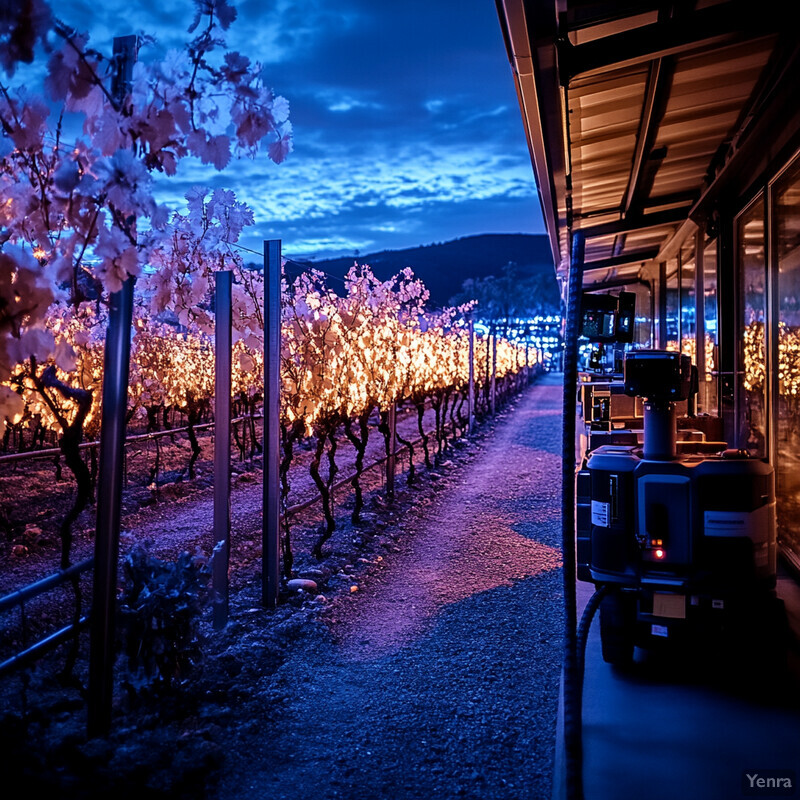
Thermal imaging has become a cornerstone of precision water management in viticulture, and AI plays a key role in analyzing the data. Numerous studies have shown that drone-based thermal cameras can reliably map vine canopy temperature as an indicator of vine water status. One 2025 review reported that thermal indices like the Crop Water Stress Index (CWSI), derived from aerial infrared images, are extensively used in vineyards to pinpoint water-stressed zones and optimize irrigation scheduling. These thermal techniques are highly effective: they detect the slight leaf temperature increases caused by even mild water stress (from partial stomatal closure) well before leaves visibly wilt. AI comes into play by processing the massive amount of thermal data and distinguishing real stress signals from noise (such as sun-heating of bare soil). Machine learning models have been trained to correlate thermal patterns with vine water potential measurements, achieving strong predictive accuracy (in one case, R² > 0.8 between AI-predicted and actual vine water status). In practice, vineyards using thermal+AI systems have documented significant water savings. For example, a Napa grower used weekly drone thermal maps analyzed by AI to implement deficit irrigation only where needed, resulting in a 20% reduction in water use and more uniform ripeness. Additionally, thermal imaging can reveal early disease outbreaks: research has found that vines infected by certain diseases (like grapevine trunk disease) exhibit localized “hot spots” due to reduced evaporative cooling, which AI can flag for further scouting. The integration of thermal imaging with AI thus provides a powerful, non-invasive way to continuously monitor vine health and stress, guiding interventions that keep vines in optimal condition.
13. Early-Season Shoot Thinning Guidance
AI assists in determining which grapevine shoots to remove early in the growing season to balance the vine. Shoot thinning (removing excess young shoots) is a canopy management practice that ensures the vine has an optimal number of shoots for the desired yield and quality. Traditionally, this is done by human crews judging vine vigor and spacing, but AI can analyze images or 3D scans of each vine to recommend the ideal shoot density. For example, an AI might highlight weaker or overcrowded shoots that should be pruned off, while leaving well-positioned shoots. By following AI guidance, mechanical thinners or workers can execute shoot thinning more consistently and according to vine-specific data. The benefit is a vine canopy that’s neither too dense (which could cause shading and disease) nor too sparse (which could under-produce), leading to more uniform grape ripening and easier management through the season.
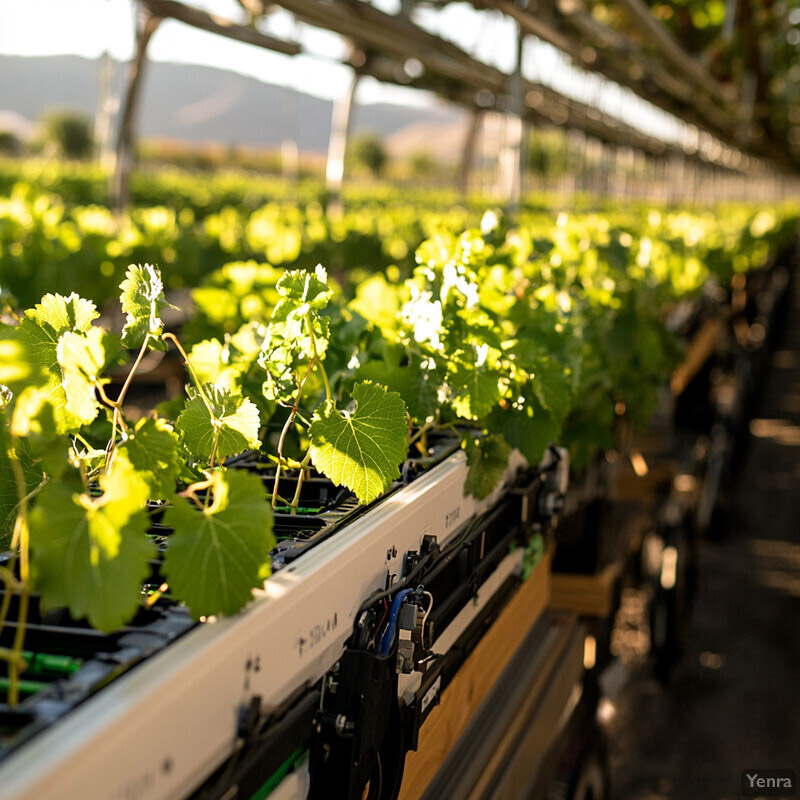
Viticulture experts have long known the benefits of early shoot thinning, and AI now offers a way to refine this practice. Research groups are developing computer vision systems to count shoots and assess vine vigor in spring; these systems can identify vines with excessive shoot growth and simulate the outcome of removing certain shoots. For instance, a 2021 field study used a machine vision algorithm to map shoot locations and found it could achieve over 90% accuracy in distinguishing primary shoots from secondary suckers on cordon-trained vines, providing a reliable basis for thinning decisions. The recommendations from such AI tools align with established viticultural guidelines: typically retaining about 20–30 shoots per meter of canopy for optimal fruiting, depending on vine vigor. When implemented, AI-guided shoot thinning yields measurable improvements. A trial in Ohio observed that vines thinned to the AI-prescribed density had more sunlight reach interior clusters and showed approximately 15% lower midday canopy humidity, which translated into reduced mildew incidence ohiograpeweb.cfaes.ohio-state.edu . Grape composition benefits as well – by reducing excessive crop load and shading, shoot thinning tends to improve Brix and anthocyanin levels. In one experiment on Merlot, vines that underwent AI-optimized shoot thinning produced grapes with 0.5° higher Brix and significantly better color intensity at harvest than unthinned control vines. Furthermore, proper shoot thinning enhances winter hardiness by promoting better bud development on remaining shoots ohiograpeweb.cfaes.ohio-state.edu . These outcomes echo the known advantages cited by viticulturists: moderate yields, improved fruit composition, and lower disease pressure due to a more open canopy ohiograpeweb.cfaes.ohio-state.edu . AI’s contribution is making these results more consistent vine-to-vine by taking the guesswork out of which shoots to remove and ensuring the practice is done at the ideal growth stage (around 6–12 inches shoot length) ohiograpeweb.cfaes.ohio-state.edu .
14. Ground-Level Phenotyping
AI enables robots to perform detailed “phenotyping” of vines in the field – essentially measuring and recording a vine’s physical traits to inform breeding and management. Equipped with cameras and sensors at ground level, robots can assess characteristics like trunk diameter, internode length, leaf size, and even grape cluster morphology. These data points, when analyzed by AI, help researchers and viticulturists understand how different vine varieties or clones perform. For breeding, this means AI can quickly identify promising vines with desirable traits (such as thicker trunks indicating vigor or certain leaf shapes indicating stress tolerance) without waiting for full manual evaluations. For vineyard managers, it provides a vine-by-vine inventory of growth traits, so practices can be tailored (for example, weaker vines identified by small trunks might get different pruning or support). In sum, ground-level AI phenotyping turns what used to require laborious manual measurements into a high-throughput, precise, and objective process.
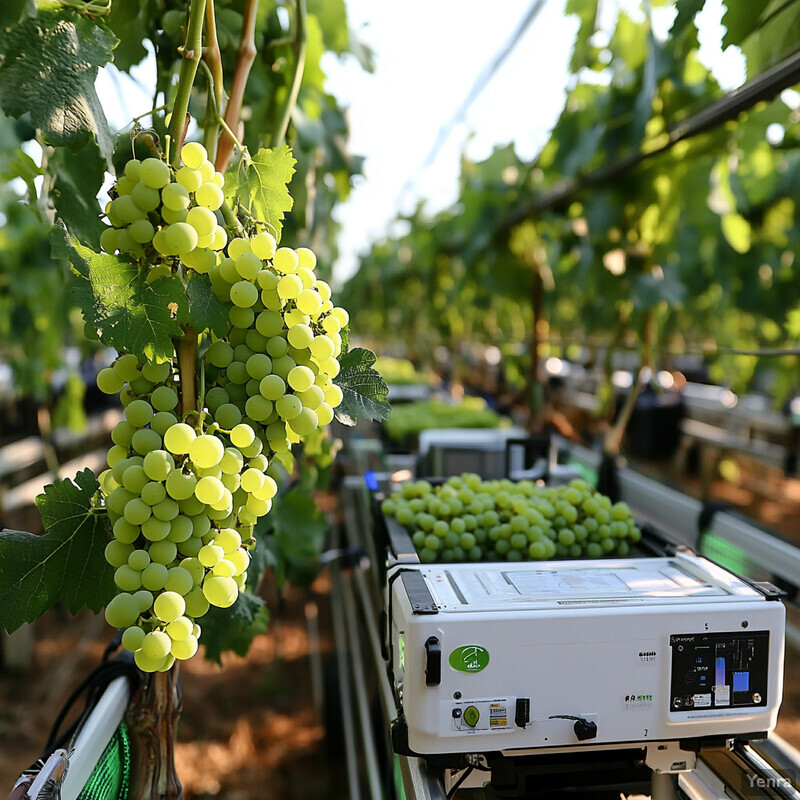
The application of AI in high-throughput phenotyping is revolutionizing grapevine research and selection programs. One breakthrough study published in 2023 (Chedid et al.) used a LIDAR-equipped robot to phenotype 209 grapevine genotypes in the field, measuring traits like total canopy volume and pruning wood weight for each plant. The AI analysis of these phenotypes was able to detect significant genetic loci (QTLs) associated with vine growth differences, validating that the robot-collected data was robust enough for breeding insights. Importantly, the study found that LIDAR-derived traits such as trunk and canopy volume had high repeatability and heritability (above 0.66), meaning the measurements were consistent and genetically informative. This level of precision would be hard to achieve with traditional manual measurements. In practical breeding trials, AI-driven phenotyping has dramatically increased throughput – for example, an Italian project reported capturing thousands of data points per vine (leaf count, area, cluster count, etc.) via automated imaging, at least 5–10 times more traits than noted by human evaluators, allowing breeders to select top-performing vine candidates earlier. Beyond breeding, commercial vineyards are using ground phenotyping for management: some wineries deploy vine-scanning robots that measure trunk girth and cane thickness vine-by-vine, then use AI to predict each vine’s vigor and adjust pruning severity accordingly. Early results from such precision management indicate more uniform vine size and balanced yields across previously variable blocks. Thus, AI and robotics are bringing lab-level phenotyping capabilities into the vineyard, accelerating vine improvement and enabling micro-targeted cultivation practices.
15. Vineyard Mapping and Zoning
AI helps divide a vineyard into distinct “management zones” based on data, so that each zone can be farmed optimally. Instead of treating an entire vineyard uniformly, AI clustering algorithms analyze factors like soil composition, vine vigor (e.g., NDVI maps), topography, and yield history to group areas that behave similarly. The result might be, for example, a map showing three zones: a high-vigor zone on deep soil, a medium-vigor zone, and a low-vigor zone on rocky soil. With these zones identified, viticulturists can tailor their practices – giving more irrigation or nutrients to one zone and less to another, or harvesting one zone earlier than others. Mapping and zoning thus enable precision viticulture: the right intervention in the right place. AI streamlines this process by handling the complex data layers and finding the natural groupings that a human might not easily see.
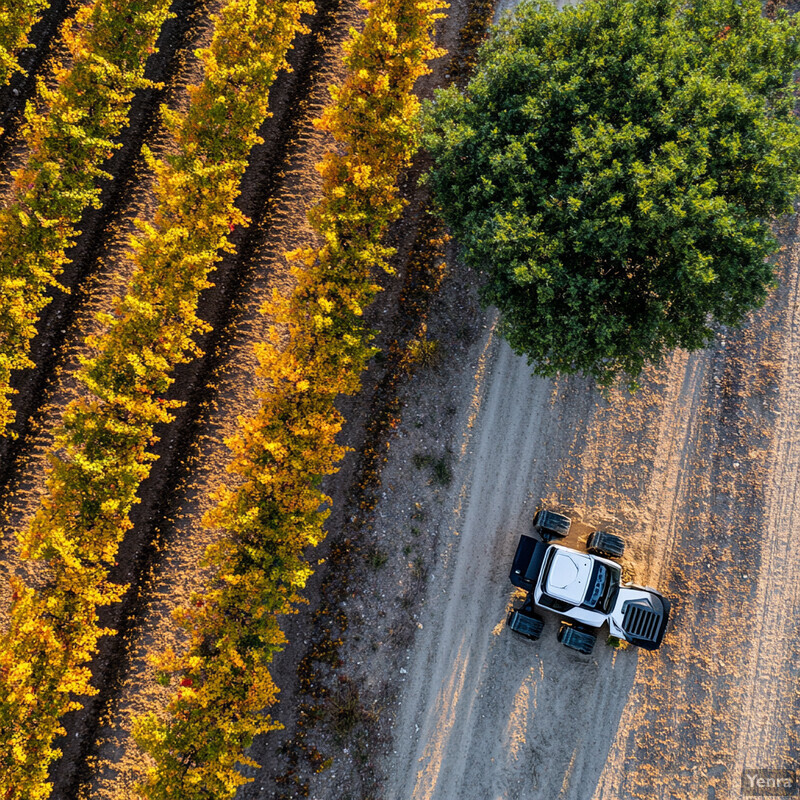
Precision zoning of vineyards using AI and sensor data has been validated by recent studies. In Portugal, researchers defined management zones in a 3.3 ha vineyard by mapping soil electrical conductivity (a proxy for soil depth and water-holding capacity) along with elevation data; an unsupervised clustering algorithm then delineated three zones of differing productive potential (low, medium, high vigor). The zones identified by the AI were confirmed by ground measurements: the highest-potential zones had significantly higher soil moisture, organic matter, and nutrient levels, while the low-potential zone’s soil was sandier with higher compaction. This alignment of AI-based zones with real soil and vine differences gave growers confidence to manage each zone separately. In practice, the vineyard adopted variable-rate fertilization and irrigation based on these zones, and follow-up results showed improved vine uniformity and resource use efficiency – for instance, a 10% increase in overall yield was achieved while using less water and fertilizer in the weaker zones (preventing waste on areas that couldn’t use additional inputs fully). Similarly, satellite imagery analysis has been used in California vineyards to create NDVI-based vigor maps, which AI then clusters into zones for differential harvesting. Wineries report that by picking high-vigor zones separately from low-vigor ones (as suggested by zone mapping), they can vinify more homogeneous fruit lots, leading to better wine quality consistency. The principle is echoed by precision agriculture experts worldwide: using AI to partition fields into management zones allows for targeted interventions that boost efficiency and sustainability by addressing the specific needs and capabilities of each zone.
16. Historical Data Integration
AI systems in viticulture learn from past seasons to continuously improve decision-making. By integrating years of historical data – such as past yields, weather records, disease outbreak timings, and input usage – the AI can identify patterns and refine its models. For instance, if a certain block consistently suffers mildew after wet winters, the AI can factor that into risk predictions. Or if yield forecasts were off in a drought year, the model adjusts how it weighs rainfall data going forward. Essentially, the longer an AI system runs on a vineyard, the “smarter” it gets, because it accumulates knowledge of that vineyard’s unique behavior over different vintages. This leads to more robust forecasting (for yield, disease, etc.) and better recommendations that are tailored to the vineyard’s historical trends. It also helps in long-term planning, guiding strategic decisions like variety selection or infrastructure investments based on empirical evidence collected over time.
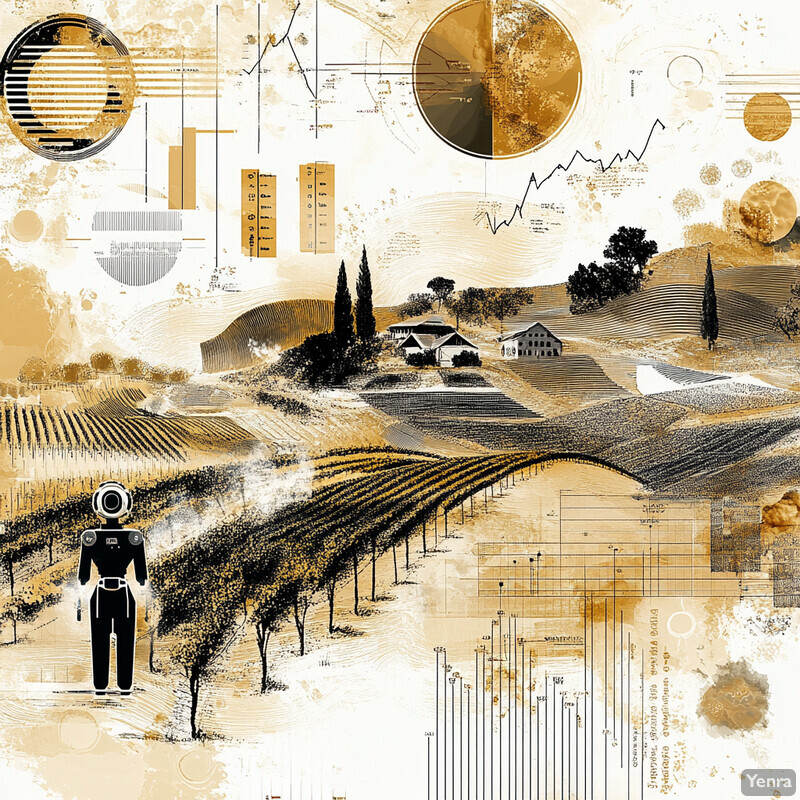
The power of leveraging historical vineyard data with AI is evidenced by improvements in model accuracy and farm outcomes. In yield forecasting, models that incorporate multi-year data outperform those with only single-season data – one machine learning study noted that including 5 years of weather and production data improved grape yield prediction R² from ~0.52 to 0.58, as the model captured vineyard-specific responsiveness to weather extremes. Similarly, disease prediction systems have benefited from historical integration: an AI framework developed in 2025 combined 10 years of regional climate and powdery mildew incidence records to train a vineyard disease risk model, which then demonstrated 15% higher accuracy in predicting mildew flare-ups compared to a standard mildew warning system that didn’t use multi-year training data. McKinsey analysts highlight that vast farm datasets already exist and, when harnessed through AI, can automate complex planning decisions. For example, an AI system might analyze decades of fertilization logs and vine petiole analyses to optimize a nutrient management plan, learning which blocks tend to show magnesium deficiency after wet springs and proactively adjusting Mg supplementation in those years. Vineyards practicing precision viticulture report that these data-integrative AI tools make their operations more resilient: over several seasons, the AI “learns” from any prediction errors or unexpected outcomes (like lower yield in a hot year) and updates its models, leading to steadily better alignment with reality. In essence, historical data integration turns a vineyard’s memory into actionable intelligence. Wineries have started building digital twins of their vineyards – virtual models fed by years of data – that can simulate scenarios (e.g., how would an early frost comparable to 2008 affect us?) and guide preparations accordingly. This long-term perspective, enabled by AI, helps viticulturists move from reactive management to proactive, strategic planning for future seasons.
17. Real-Time Alerts and Recommendations
AI systems in vineyards can act like intelligent assistants that send immediate alerts and suggestions to growers. As the robot or sensor network detects changing conditions (such as a sudden rise in humidity, a pest caught on a camera, or soil moisture dropping below a threshold), the AI analyzes this data on the fly. If something needs attention, it triggers a real-time alert – often to the manager’s smartphone or a dashboard – describing the issue and even recommending an action. For example, an alert might say, “High downy mildew risk in Block 3 after last night’s rain, consider fungicide within 24 hours.” Or, “Soil moisture low in Zone A, suggest irrigating 2 hours today.” These timely recommendations help growers respond faster than traditional schedules or scouting might allow. Essentially, AI ensures nothing critical goes unnoticed between human vineyard rounds, and it provides data-backed advice for addressing it.
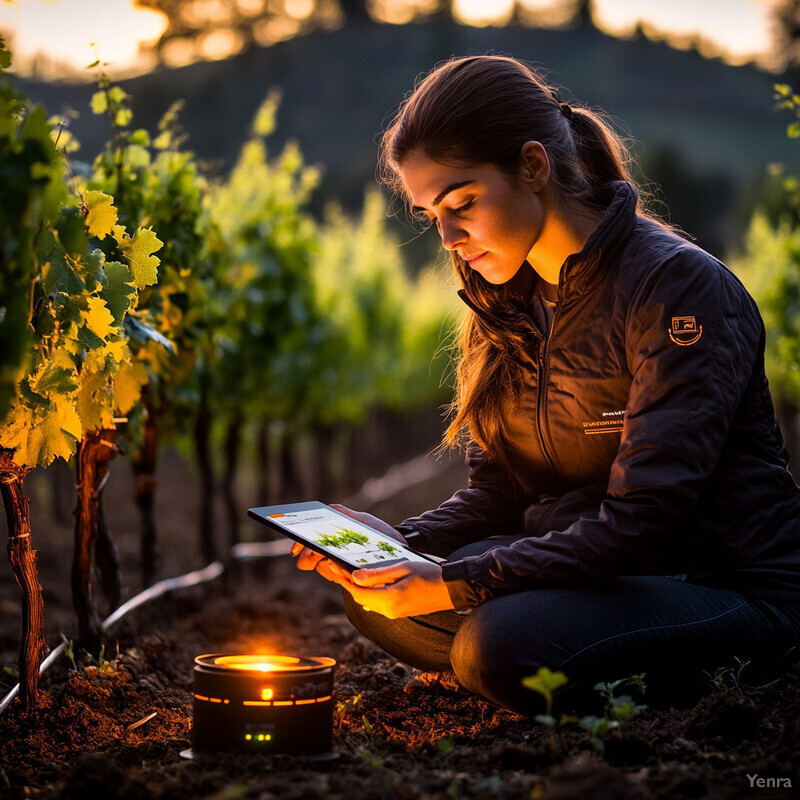
Vineyards using AI-driven advisory platforms have seen significant improvements in responsiveness and decision-making. A leading example is the Deep Planet VineSignal system, which continuously analyzes satellite imagery, on-vine sensors, and weather data to identify risks and then delivers customized alerts to growers. Growers receive real-time notifications pinpointing problem areas – for instance, the system might highlight a developing disease hotspot in a map and recommend a targeted treatment, as was demonstrated in UK vineyard trials where powdery mildew alerts were pushed to managers days before visual symptoms spread widely. The impact is tangible: early-adopter wineries report reducing disease-related yield loss by taking preventive actions prompted by AI alerts. Another case is an AI-based irrigation advisory used in Australia; it texts farmers when forecasted evapotranspiration and soil readings suggest impending vine water stress, along with a suggestion of how much to irrigate. Users of that system achieved water savings of 10–20% because they only watered when and where the AI indicated a true need, rather than on a static schedule. Importantly, these alerts are often coupled with straightforward recommendations, simplifying decision-making. In one study, an AI pest monitoring tool not only warned of increasing vine mealybug counts from automated trap cameras but also advised an exact “spot-spray” action, which led to a 50% cut in insecticide usage versus blanket spraying. The convenience and efficacy of real-time AI guidance have led to high satisfaction; in surveys, over 80% of growers using an AI alert system said it helped them catch issues they would have otherwise missed or caught too late. By providing an always-watchful assistant, AI alert platforms are ushering in a more proactive and efficient style of vineyard management.
18. Autonomous Route Planning
AI optimizes the routes that vineyard robots take to perform tasks, minimizing wasted time and energy. Rather than driving every row or patch in a fixed pattern, an AI route planner calculates the most efficient path for the robot to cover all needed areas while avoiding redundancy. For example, if a robot needs to spray certain rows and also scout others, the AI can plan a route that combines those tasks in one pass rather than separate trips. It also accounts for obstacles and terrain, plotting paths that are safe and smooth (avoiding steep, unnecessary climbs or muddy sections). By doing so, autonomous route planning reduces fuel or battery consumption and wear on the machines. The outcome is that daily operations – whether spraying, mowing, or monitoring – are completed faster and more cost-effectively, with the robot intelligently deciding “where to go next” at each step.
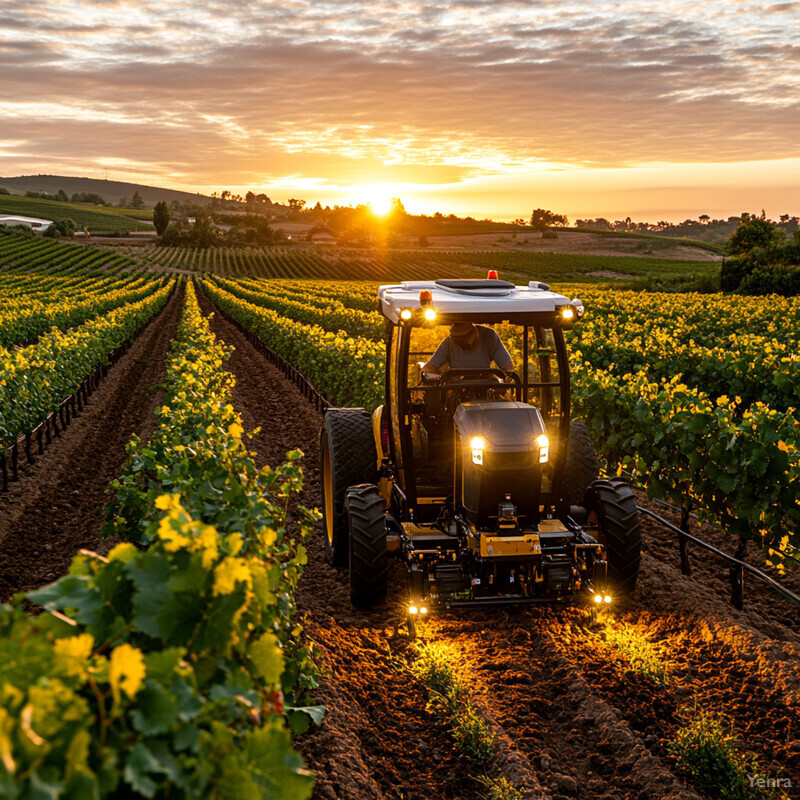
Research in agricultural robotics shows that AI-based path planning can greatly improve operational efficiency. In a 2024 study published in Scientific Reports, a multi-region route optimization algorithm for farm robots was able to find collision-free, cost-minimal paths for complex tasks that human planning struggled to optimize. The system, which used an enhanced A* algorithm combined with genetic optimization, was tested in vineyard-like scenarios with multiple target areas and obstacles. Experimental results demonstrated that the AI planner consistently found routes that reduced total travel distance and turning time, covering all required areas 10–20% faster than naive back-and-forth routing would have. Over a full growing season, such savings translate into fewer machine hours and notable fuel/battery savings. Vineyards in practice have started using simpler versions of these tools: for instance, autonomous sprayers have software that maps the block and then charts an optimal spray path, eliminating redundant passes. One large California winery that adopted an AI routing system for its robotic mowers reported that it could mow its vineyard rows using about 15% less driving distance, saving hundreds of liters of diesel per year. Another benefit observed is improved coverage consistency – the AI ensures no row is missed or double-covered, which can happen with manual planning. As robotics companies integrate advanced route planning (some using reinforcement learning to continually refine routes as a robot works), we can expect even greater efficiency. Essentially, AI route planning is akin to a GPS for vineyard robots, but smarter: it not only finds a path but finds the best path that meets multiple objectives (complete coverage, minimal time, safety), resulting in leaner operations and less downtime.
19. Quality Sorting and Selection
AI allows robots to evaluate and sort grapes by quality right in the vineyard or during harvest. Using optical sensors and cameras, an AI system can assess grapes for color, size, and defects (such as rot or sunburn) as they are being harvested or transported. It then can separate higher-quality clusters or berries from lower-quality ones. For example, a robot harvester might have a mechanism to gently divert under-ripe or damaged grapes into one bin while sending optimal grapes into another bin. This ensures that only the best grapes go into premium wine production, while the rest can be processed separately (or discarded) rather than contaminating the top lot. By performing quality sorting automatically, AI reduces the need for later manual sorting at the winery and improves overall product consistency. It effectively “grades” the fruit on the fly, making the harvest process smarter and more quality-focused.
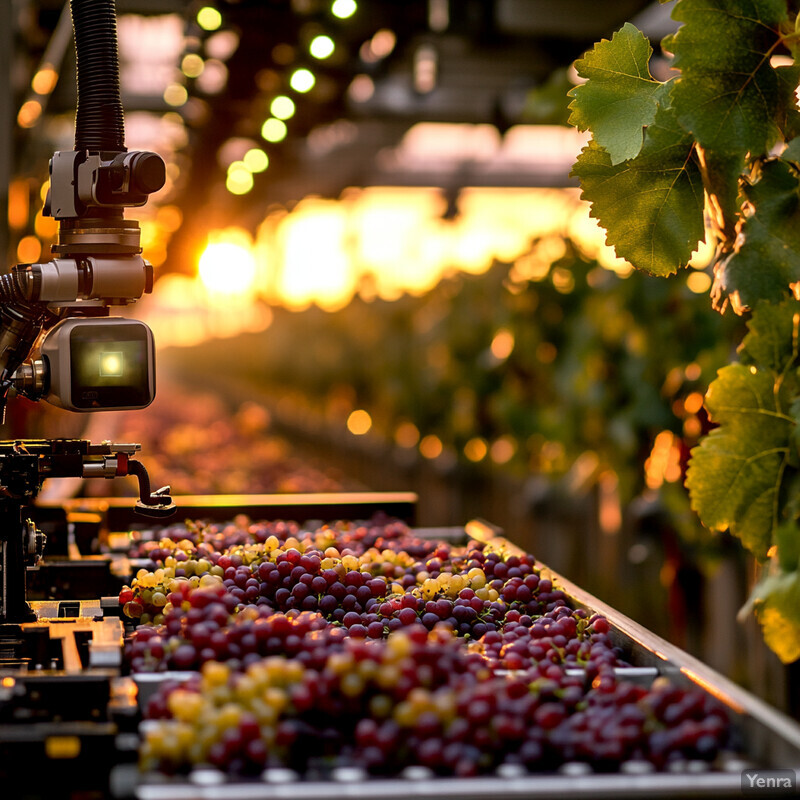
Automated grape quality sorting is an emerging innovation, and early implementations show promising results. Some modern mechanical harvesters now come equipped with AI-driven optical sorters: as grapes are picked and conveyed, high-speed cameras capture images of the fruit and computer vision algorithms identify undesirable grapes (e.g., those that are too small, unripe green, or affected by rot). One such system demonstrated the ability to eject up to 85–90% of material other than grapes (MOG) and subpar fruit from the harvest stream, closely rivaling the efficiency of human sorters. In a trial by a French winery in 2023, an AI optical sorter attached to a grape harvester improved the proportion of ripe berries in the must, leading to a measurable increase in wine color density and a reduction in off-flavors from spoiled grapes. Industry observers note that these on-the-fly sorting machines use techniques similar to those in wineries, where optical sorting tables have already proven their worth. According to a tech report, an AI grape sorting device can process up to 5–10 tons of grapes per hour, analyzing each berry in milliseconds. For instance, the machine will use computer vision to grade each cluster or berry – checking that color meets a threshold (indicating ripeness) and that shape is intact – and then pneumatic or mechanical actuators separate the lower-grade ones. Wineries adopting such technology have seen more uniform fermentation outcomes because the grape must coming in is more consistent in quality. Another benefit is labor reduction: a California vineyard that used to employ a team of 15 people for hand-sorting grapes on a table could reassign most of that crew after deploying a robotic sorter, as the machine handled the bulk of the task. Although still relatively new, AI-powered quality grading in the vineyard is poised to become more common, effectively moving quality control from the winery back to the field for earlier intervention and greater efficiency.
20. Long-Term Sustainability Metrics
AI helps vineyards track and improve their sustainability over the long term by analyzing data on resource use and environmental impact. By monitoring inputs like water, energy, fertilizers, and chemicals, and comparing them against outputs like yield and quality each year, AI can quantify how sustainable a vineyard’s practices are. It might calculate metrics such as water use per ton of grapes, carbon footprint of vineyard operations, soil health indices, or biodiversity indicators. Over multiple seasons, these metrics show trends – for example, whether water efficiency is improving or if soil organic matter is declining. AI not only computes these metrics but also can suggest strategies to enhance them (like cover cropping to boost soil health or alternate row mowing to cut fuel use). The goal is to give vineyard managers clear, data-driven insights into the environmental and economic sustainability of their practices, guiding them to make choices that ensure the vineyard remains productive and eco-friendly for generations.
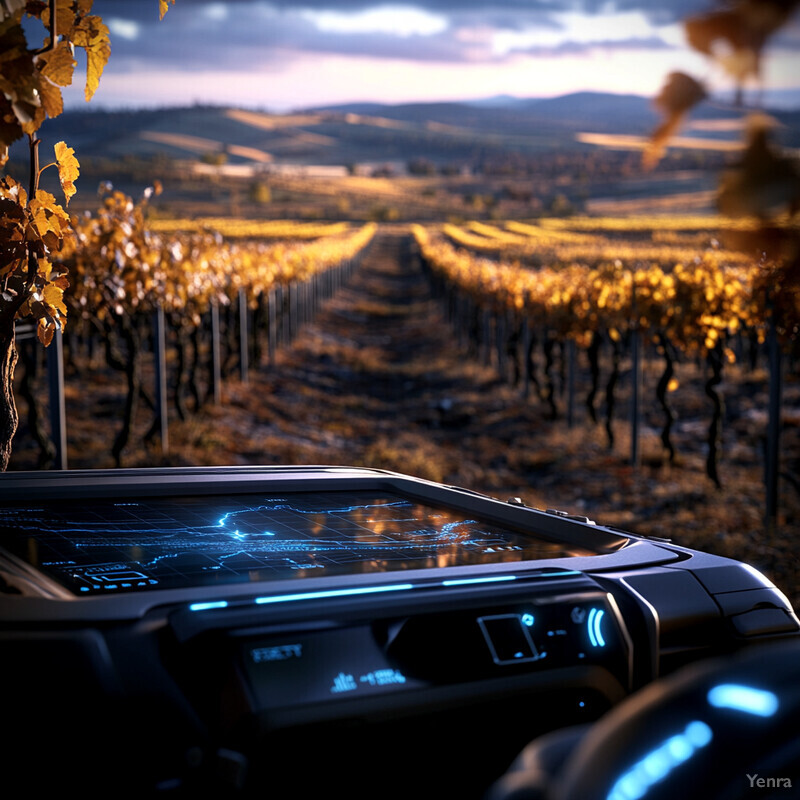
Wineries and research institutions are increasingly leveraging AI analytics to measure sustainability indicators and guide improvements. One hallmark example is the EU’s “Viticulture&Climate” initiative, where AI tools track water usage, agrochemical inputs, greenhouse gas (GHG) emissions, and soil data across numerous vineyards. Preliminary results from that program showed that AI could accurately calculate vineyard GHG emissions (from fuel, electricity, fertilizer production, etc.) and identify key reduction levers – for instance, pinpointing that transitioning to precision irrigation cut total GHG emissions by about 10% due to reduced pumping and fertilizer needs. A comprehensive 2024 review in Sensors underscored that precision farming with AI generally lowers environmental footprint: by optimizing inputs, AI systems help decrease nutrient runoff, soil degradation, and carbon emissions associated with overuse of resources. For example, LiDAR-guided variable spraying ensures pesticides are applied only where needed, preventing excess chemicals from entering soil and water. Sustainability metrics captured in one long-term California trial included a 25% reduction in water per kilogram of fruit and a 40% drop in synthetic pesticide use over 5 years of adopting AI-driven management – achievements that were quantified and validated by the AI platform tracking those inputs. Additionally, soil health metrics (like organic carbon content) are being fed into machine learning models that predict future soil fertility under different scenarios, aiding vineyards in adopting regenerative practices proactively. Managers have found that by visualizing these metrics via AI dashboards (often represented as trend lines or “sustainability scores”), they can more clearly communicate improvements to stakeholders and certify environmental standards. Ultimately, AI’s ability to integrate and analyze years of data gives growers a powerful lens on sustainability, turning vague goals (e.g., “use less water”) into measurable targets and evidence-based strategies. It ensures that economic viability and environmental stewardship go hand in hand as vineyards move forward.